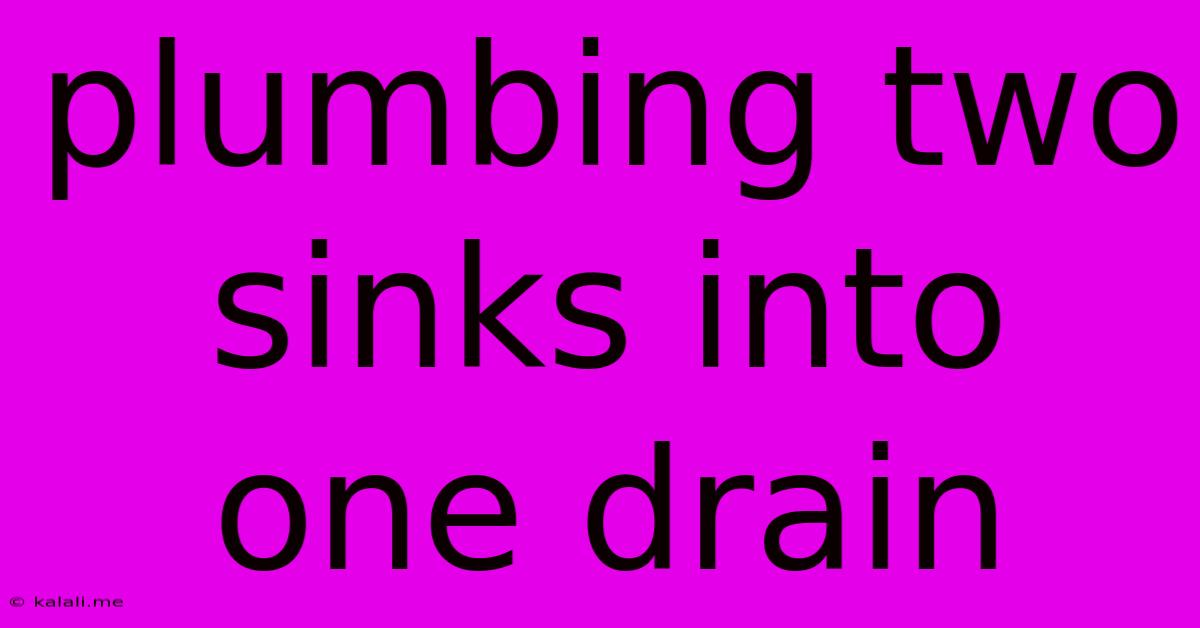Plumbing Two Sinks Into One Drain
Kalali
Jun 04, 2025 · 4 min read

Table of Contents
Plumbing Two Sinks into One Drain: A Comprehensive Guide
Connecting two sinks to a single drain line might seem daunting, but with the right tools and a methodical approach, it's a manageable DIY plumbing project. This comprehensive guide will walk you through the process, covering everything from necessary materials to troubleshooting potential issues. This project is ideal for homeowners looking to improve efficiency in their bathroom or kitchen. Whether you're renovating or simply updating your plumbing, understanding how to connect multiple sinks to one drain is a valuable skill.
Understanding the Basics:
Before you begin, understanding the basic principles is crucial. The key is to ensure proper drainage and avoid clogs. This involves using appropriately sized pipes and fittings, maintaining a consistent slope for gravity-assisted drainage, and employing a vent system to prevent sewer gases from entering your home.
Tools and Materials:
You'll need the following for this project:
- Measuring tape: Accurate measurements are essential for proper fitting installation.
- Pipe cutter/hacksaw: For cutting PVC pipes to the required lengths.
- PVC cleaner and primer: Essential for creating a strong bond between PVC pipes and fittings.
- PVC cement: The adhesive that joins PVC pipes securely.
- Adjustable wrench: For tightening and loosening various fittings.
- Slip joint pliers: Useful for gripping and turning pipes without damaging them.
- Level: Ensure your pipes are correctly sloped for efficient drainage.
- Appropriate sized PVC pipes and fittings: This includes drain pipes, tees, elbows, and a trap arm for each sink. The size will depend on the sink's drain size (typically 1.5" or 2"). Choose the correct size for the main drain line as well.
- Sink drain tailpieces: These connect the sink drain to the P-trap.
- P-traps (one for each sink, unless using a shared trap): Essential for preventing sewer gases from entering your home. Always install a trap for each sink.
- Plumber's putty: Used to seal connections between the sink and the drain assembly.
Step-by-Step Installation Guide:
-
Preparation: Turn off the water supply to both sinks. Disconnect the existing drain lines from the sinks. Carefully remove any old sealant or putty.
-
Installing the Drain Lines: Connect the sink drain tailpieces to each sink. Then, install the P-traps, ensuring they're properly sealed to prevent leaks.
-
Connecting to the Main Drain: Use a tee fitting to join the drain lines from both sinks. This tee should be connected to the main drain line leading to your home's plumbing system. Ensure the connections are tight and sealed with PVC cement. It's crucial to observe the correct slope (typically 1/4 inch per foot) to facilitate proper drainage.
-
Securing the Pipes: Use appropriate clamps or straps to secure the pipes to the wall or underside of the vanity to prevent sagging and maintain the required slope.
-
Testing for Leaks: Once everything is connected, turn the water supply back on and carefully check all connections for leaks. Look for any signs of dripping or water pooling. Address any leaks immediately by tightening connections or reapplying sealant.
-
Venting: Ensure your drain system is properly vented to prevent sewer gases from backing up into your sinks. A properly installed vent system is essential for effective drainage and to prevent unpleasant odors.
Troubleshooting Common Issues:
- Slow Drainage: This could be due to a clog, incorrect slope, or a too-small drain pipe. Check for blockages and ensure the pipes are properly sloped.
- Leaks: Leaks are often caused by improperly sealed connections. Check all connections, retighten if necessary, and apply more sealant where needed.
- Gurgling Sounds: This might indicate a venting problem. Check that the vent pipe is properly installed and unobstructed.
Choosing Shared vs. Individual P-Traps:
While generally recommended to use a P-trap for each sink, using a single, shared P-trap is possible, especially for closely spaced sinks. However, this setup carries an increased risk of clogs and potential cross-contamination. Always consider this risk before opting for a shared P-trap configuration.
Safety Precautions:
Always turn off the water supply before starting any plumbing work. Wear appropriate safety glasses and gloves. If you're unsure about any aspect of the project, it's always best to consult a qualified plumber. Improper plumbing can lead to costly water damage.
By following these steps and taking necessary precautions, plumbing two sinks into one drain can be a successful DIY project, resulting in a more efficient and organized plumbing system. Remember to prioritize safety and thoroughness throughout the process.
Latest Posts
Latest Posts
-
Can You Put A Portable Hole In A Handy Haversack
Jun 06, 2025
-
Why Did Militarys Stop Using Armor
Jun 06, 2025
-
How To Make Your Alarm Loud
Jun 06, 2025
-
Did Judas Know Jesus Would Be Killed
Jun 06, 2025
-
Find A Basis Of The Orthogonal Complement
Jun 06, 2025
Related Post
Thank you for visiting our website which covers about Plumbing Two Sinks Into One Drain . We hope the information provided has been useful to you. Feel free to contact us if you have any questions or need further assistance. See you next time and don't miss to bookmark.